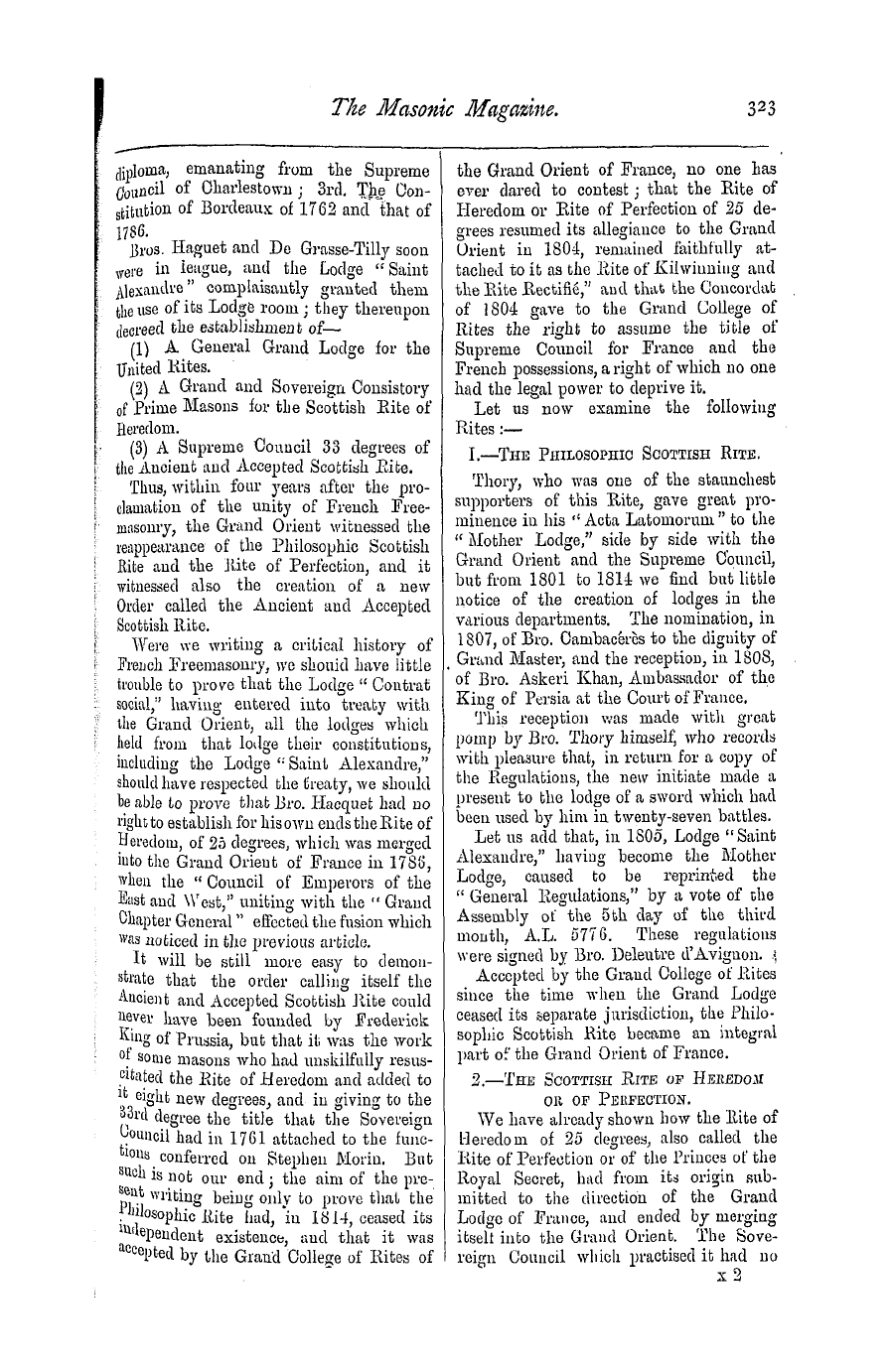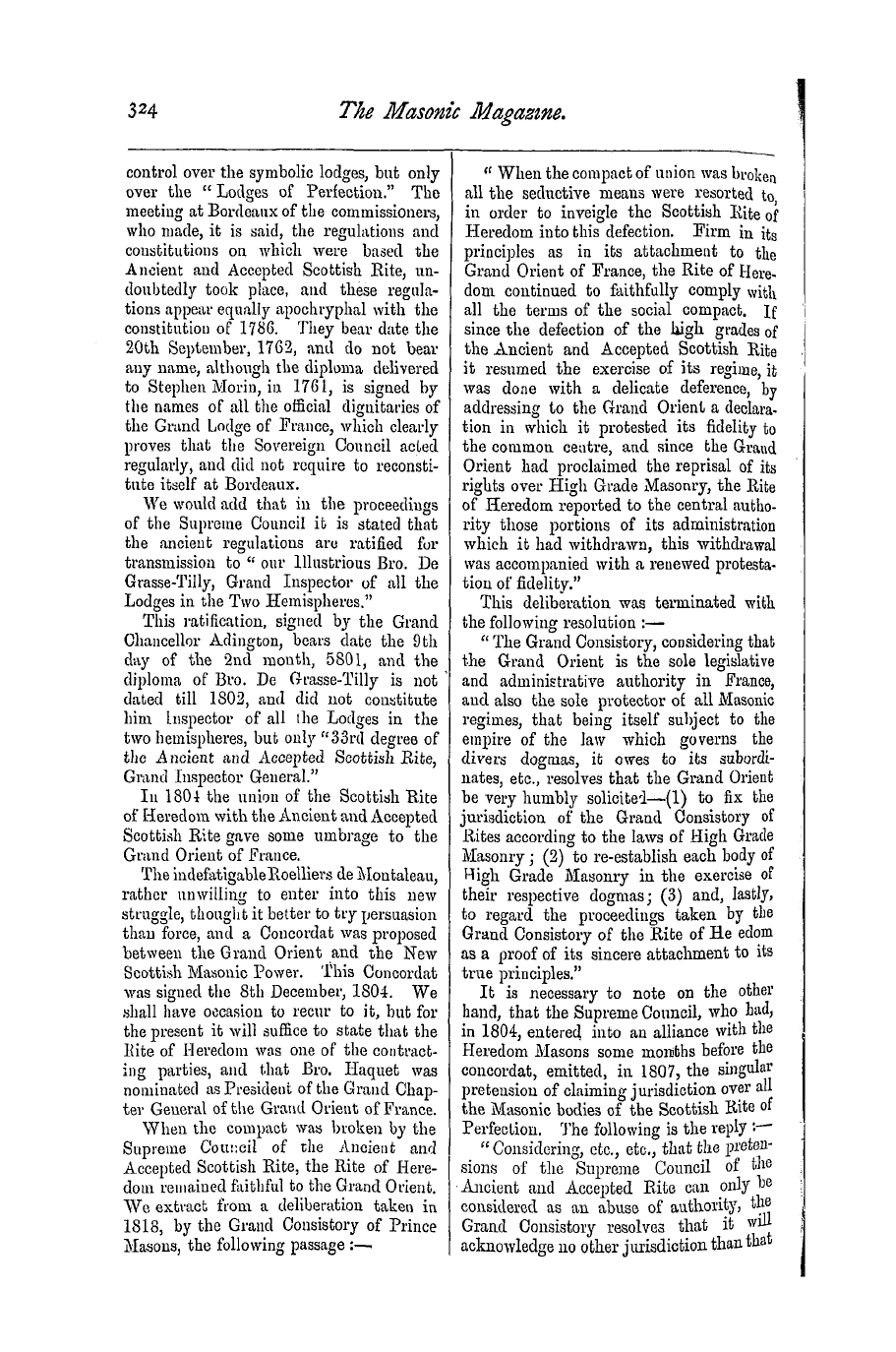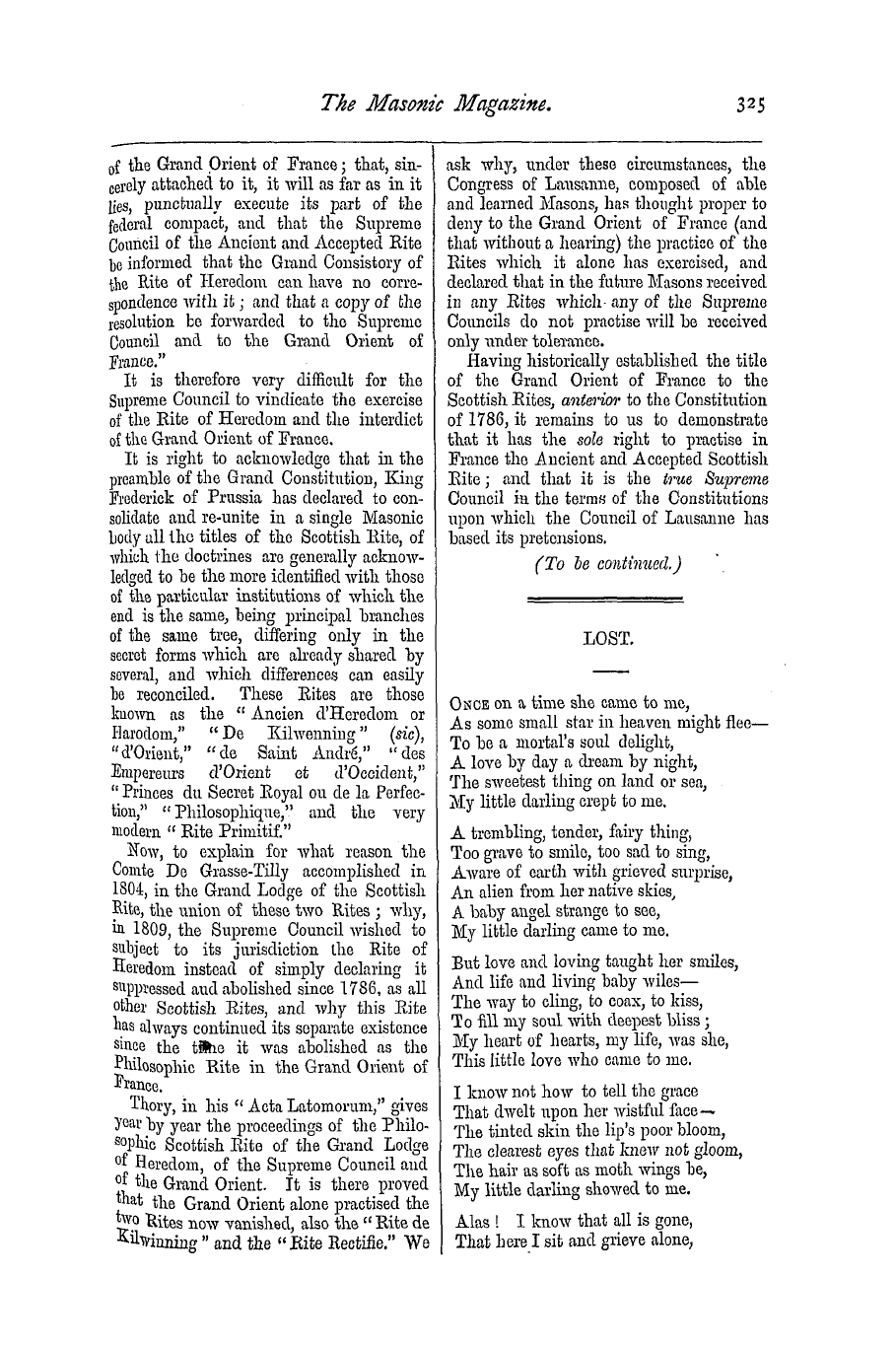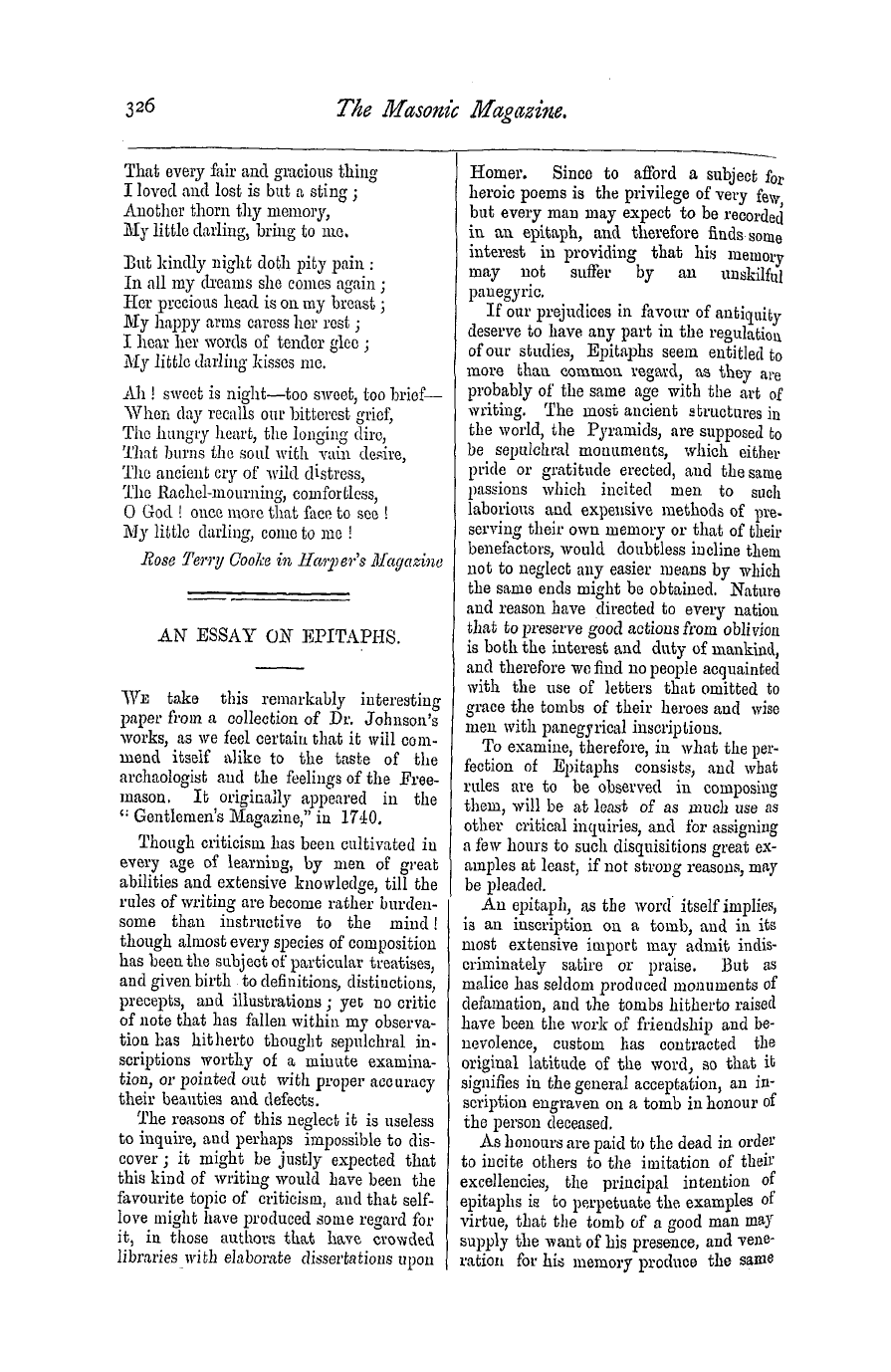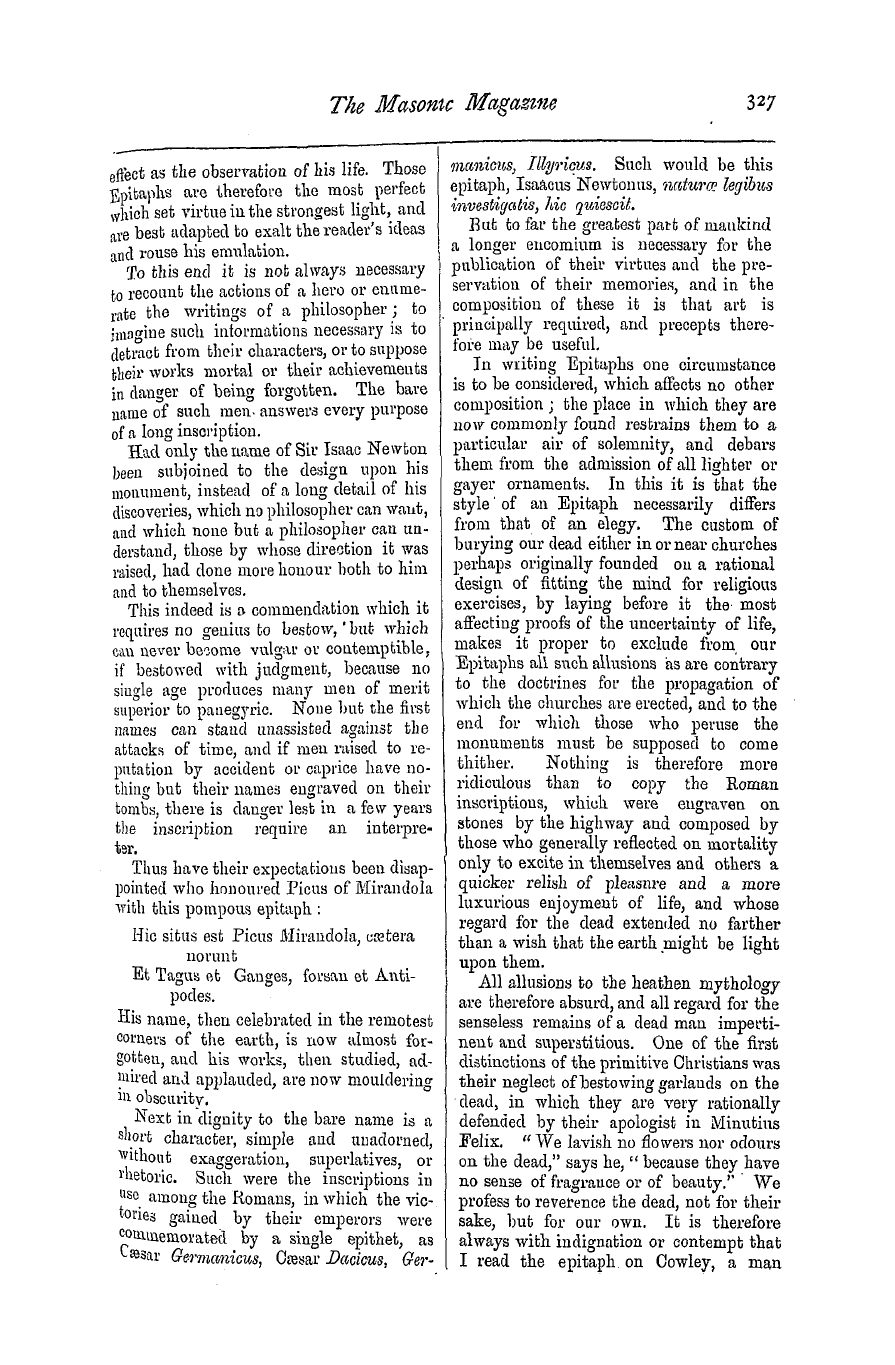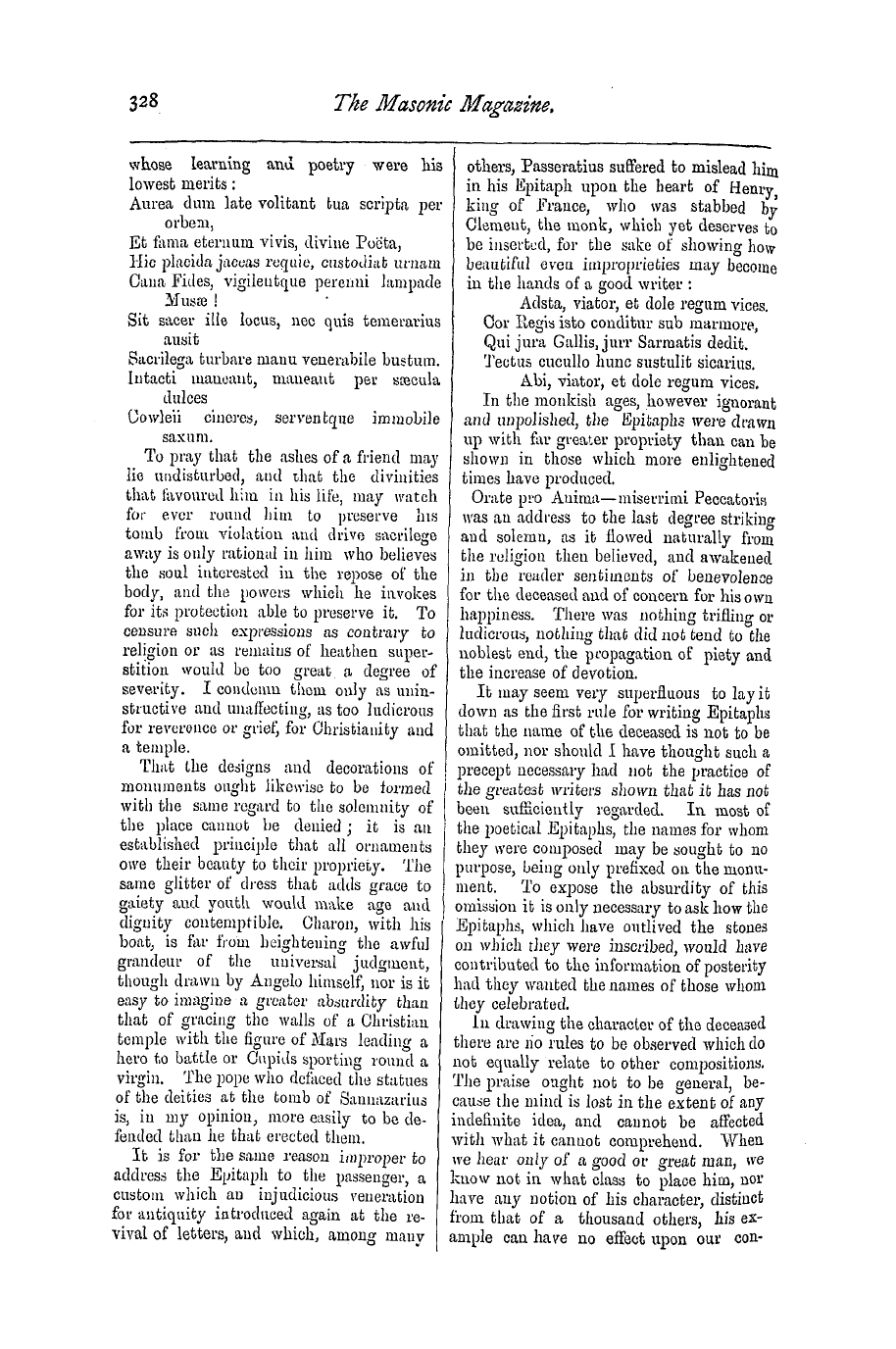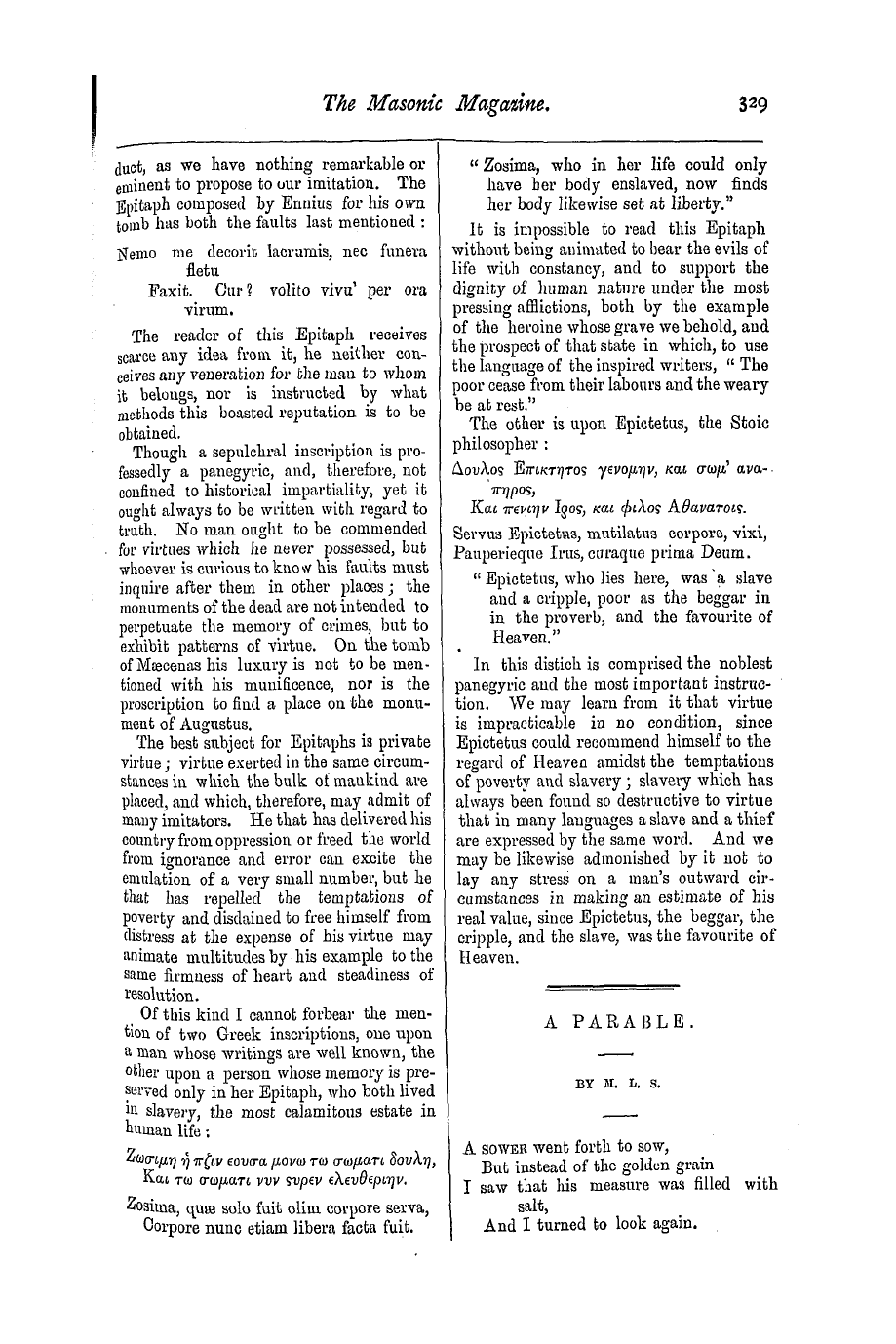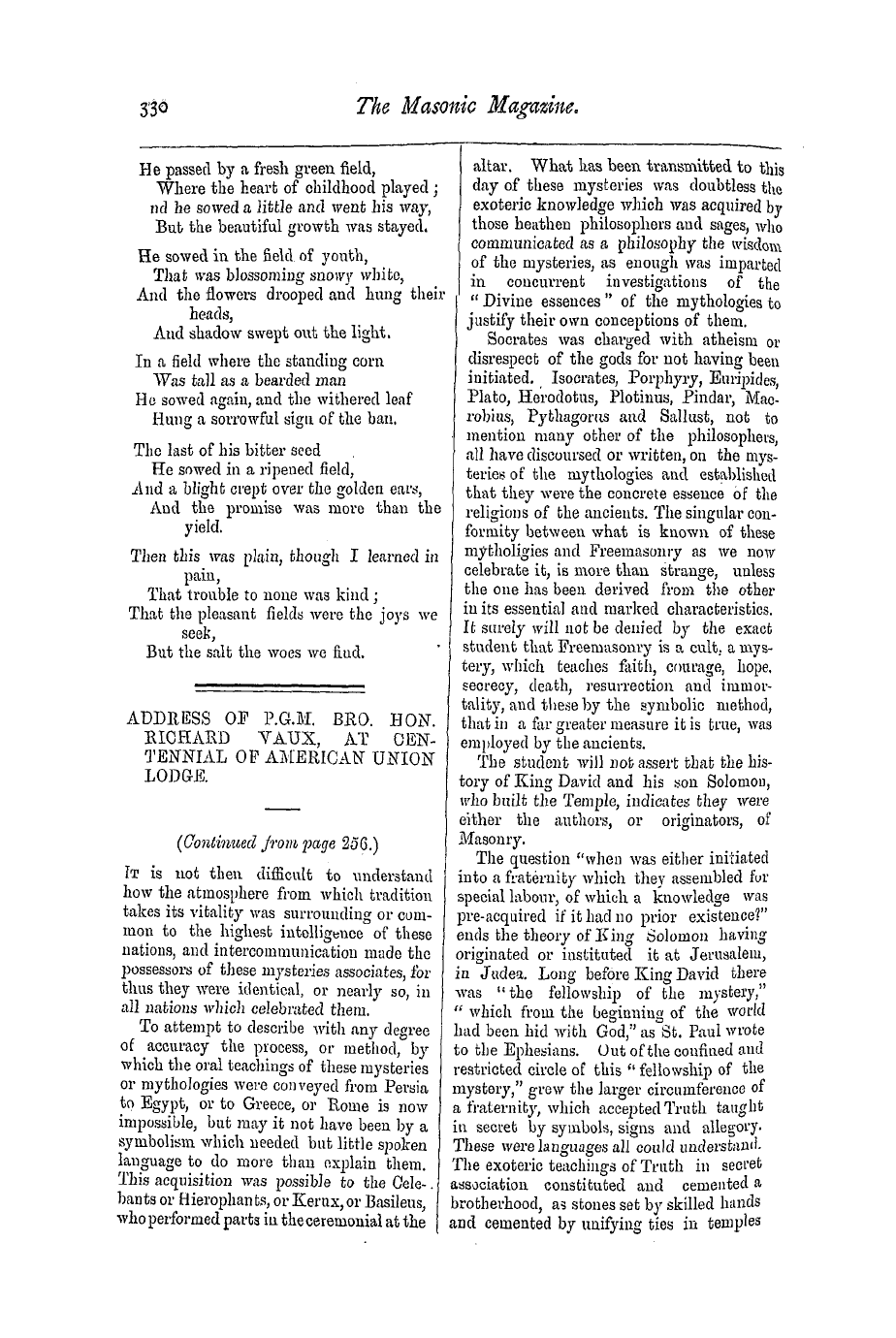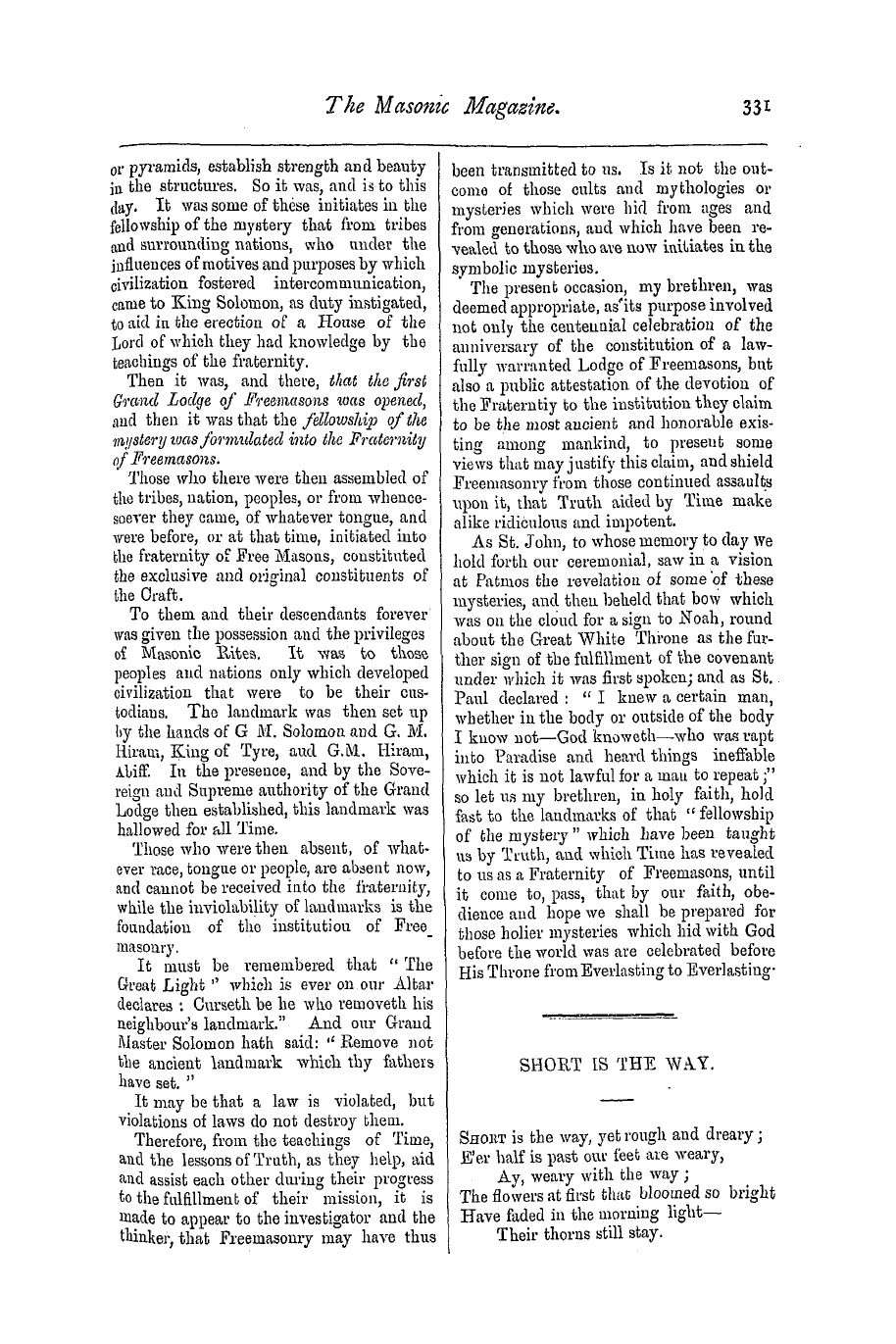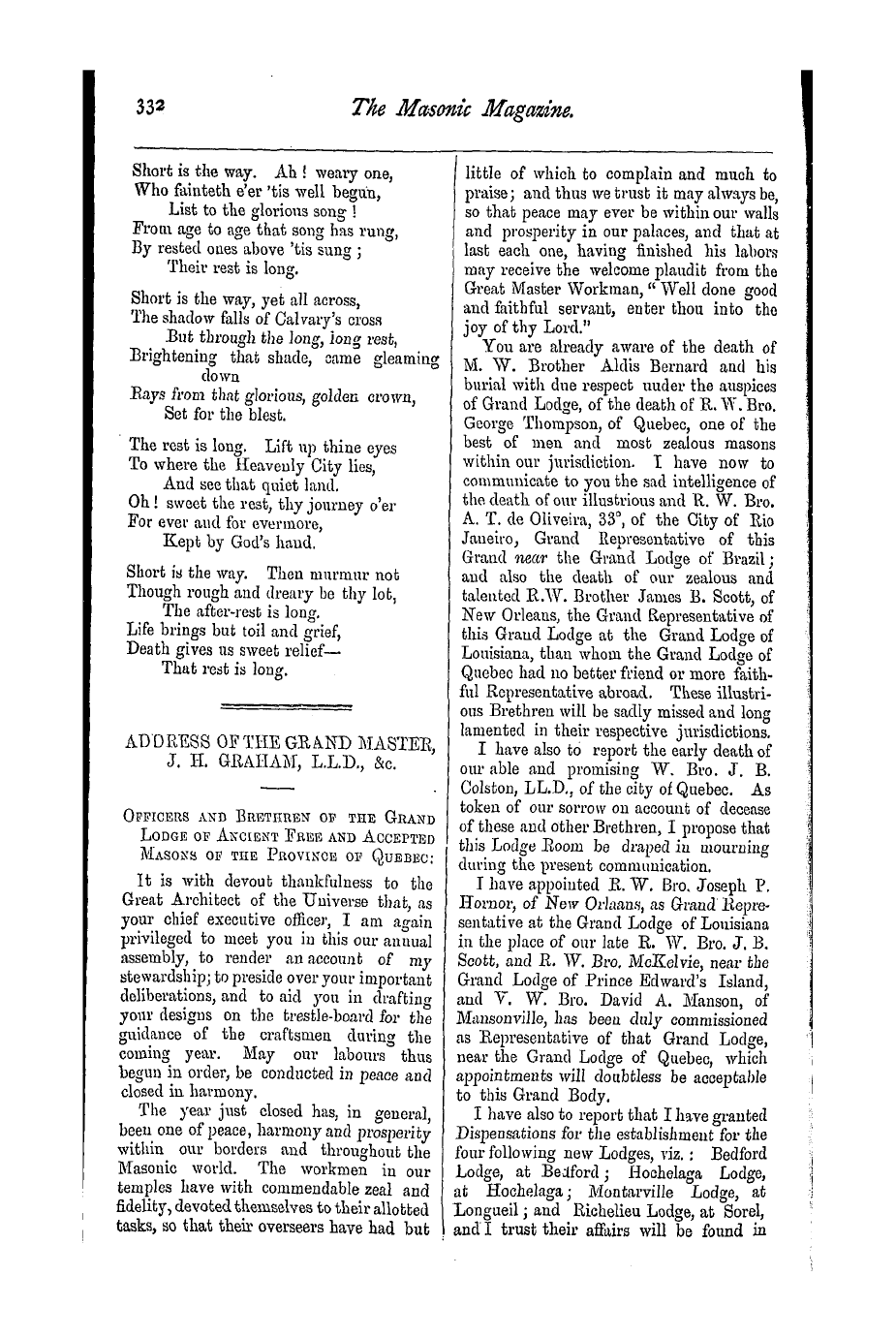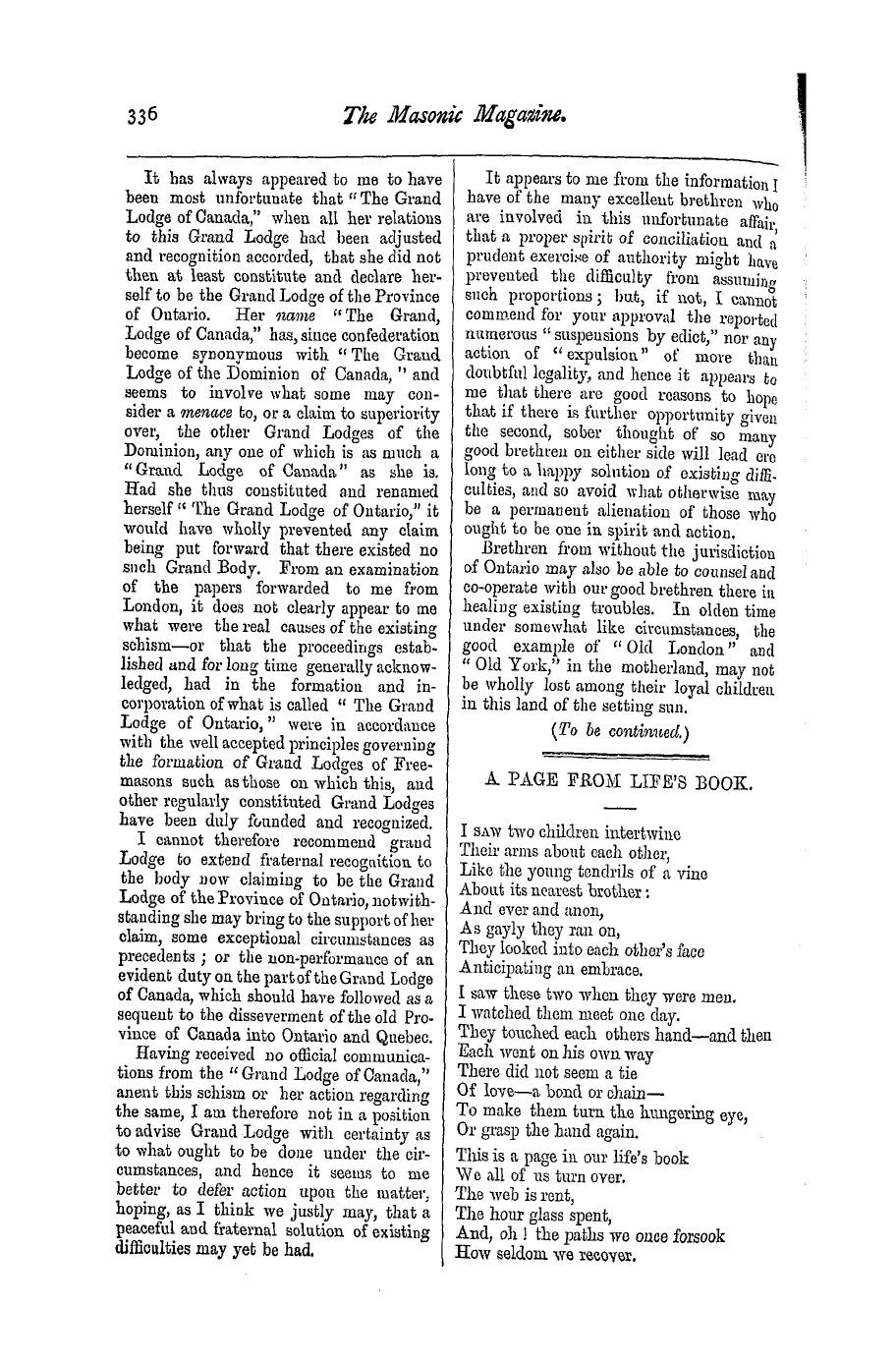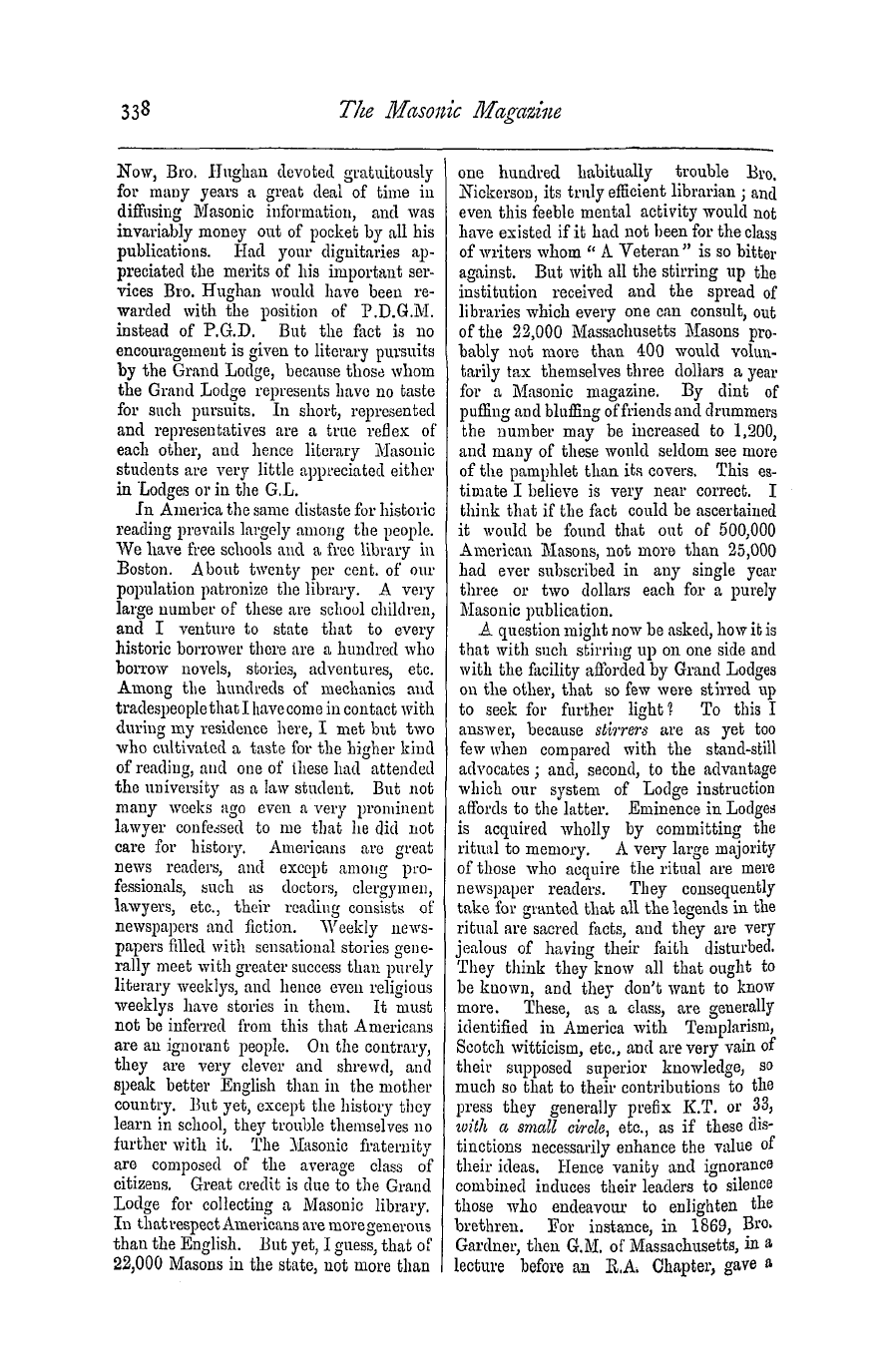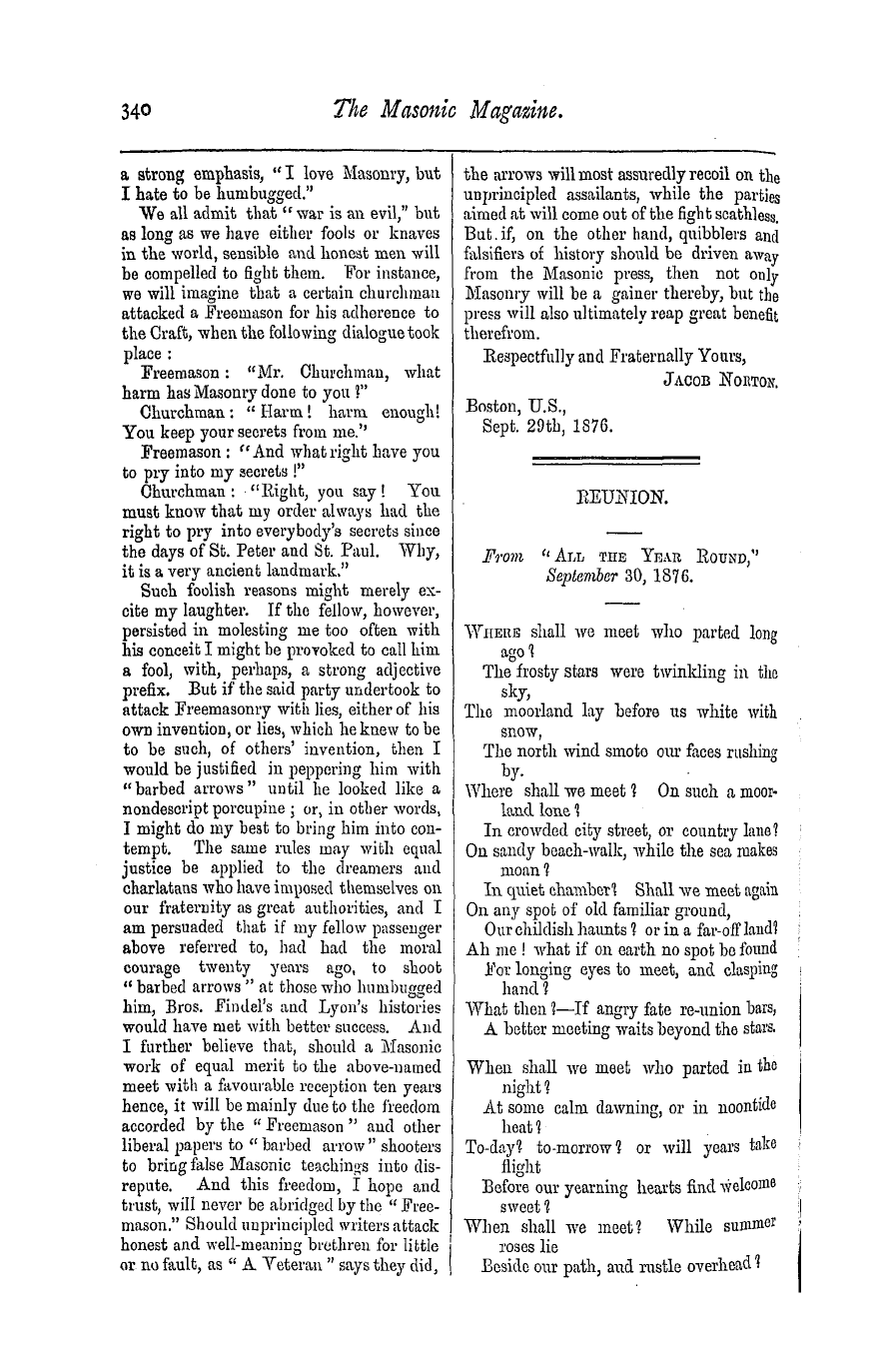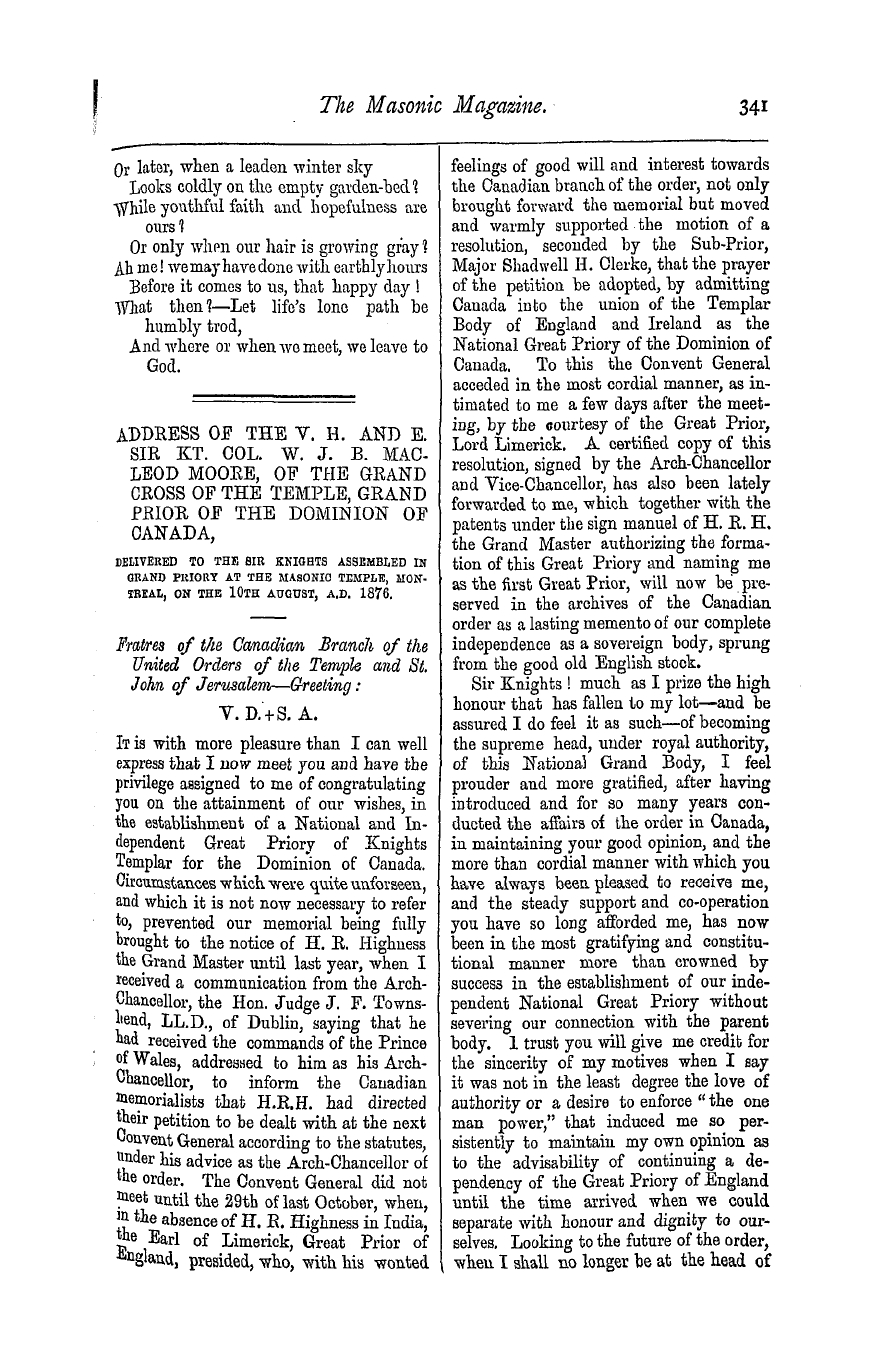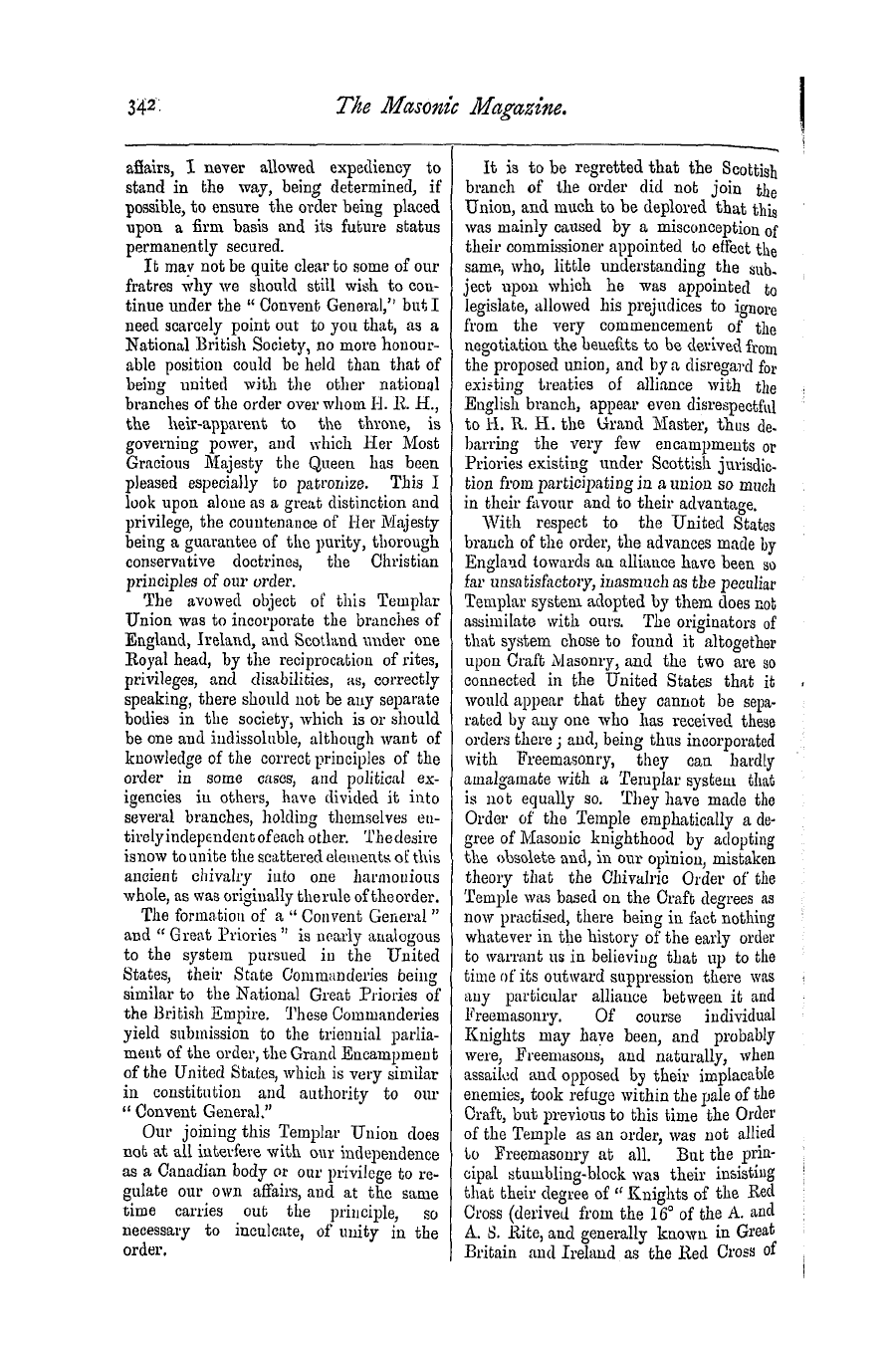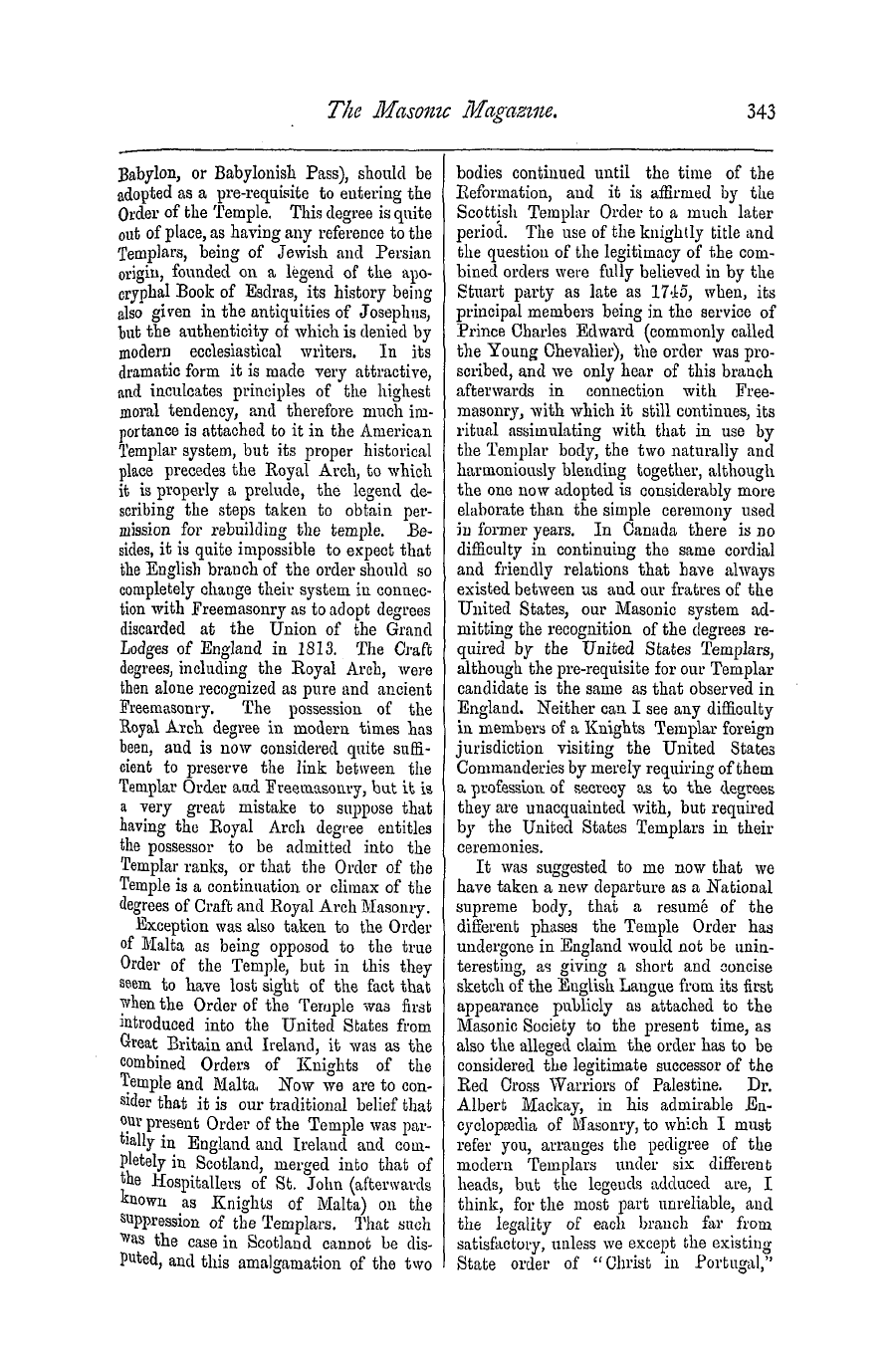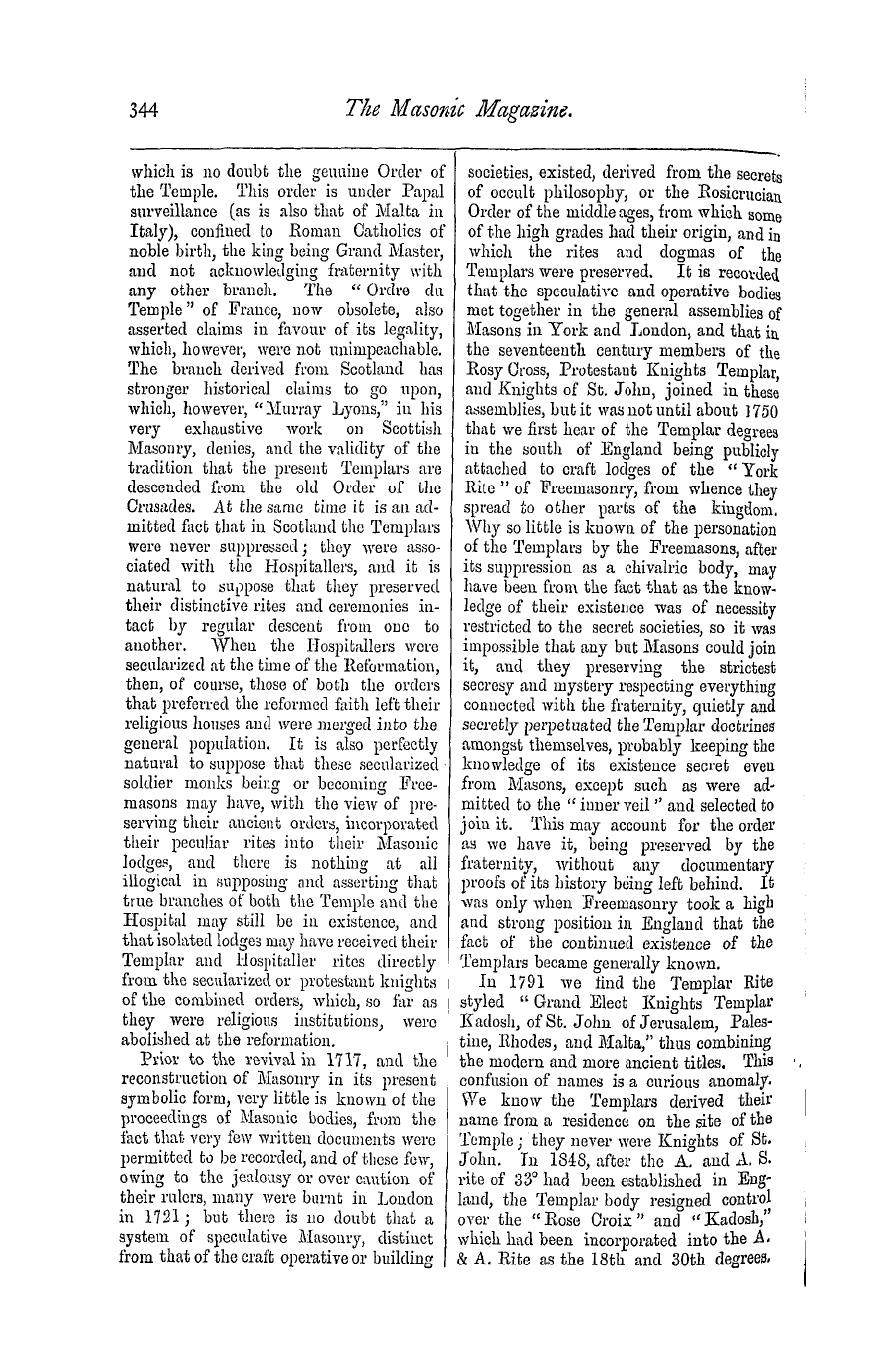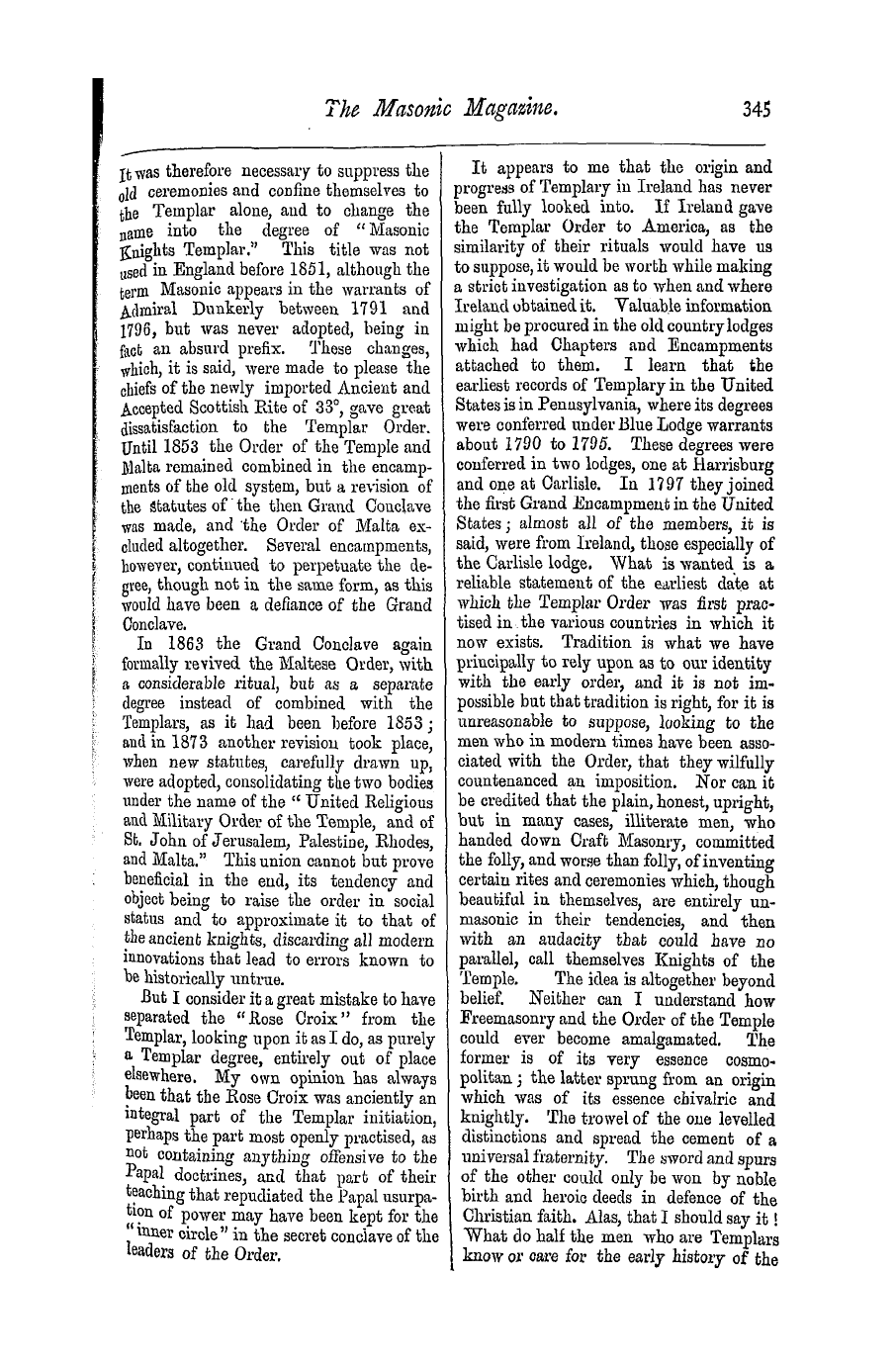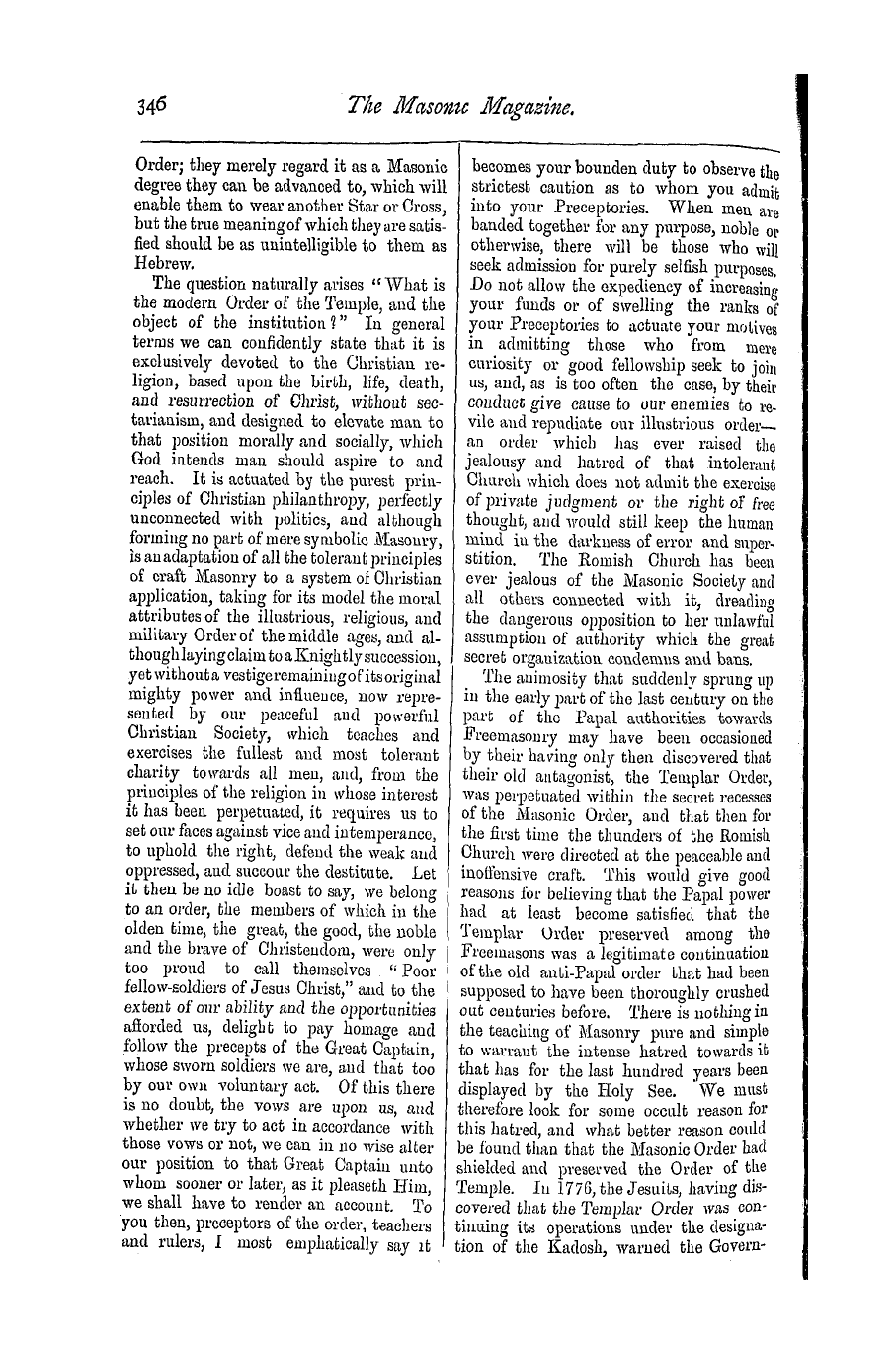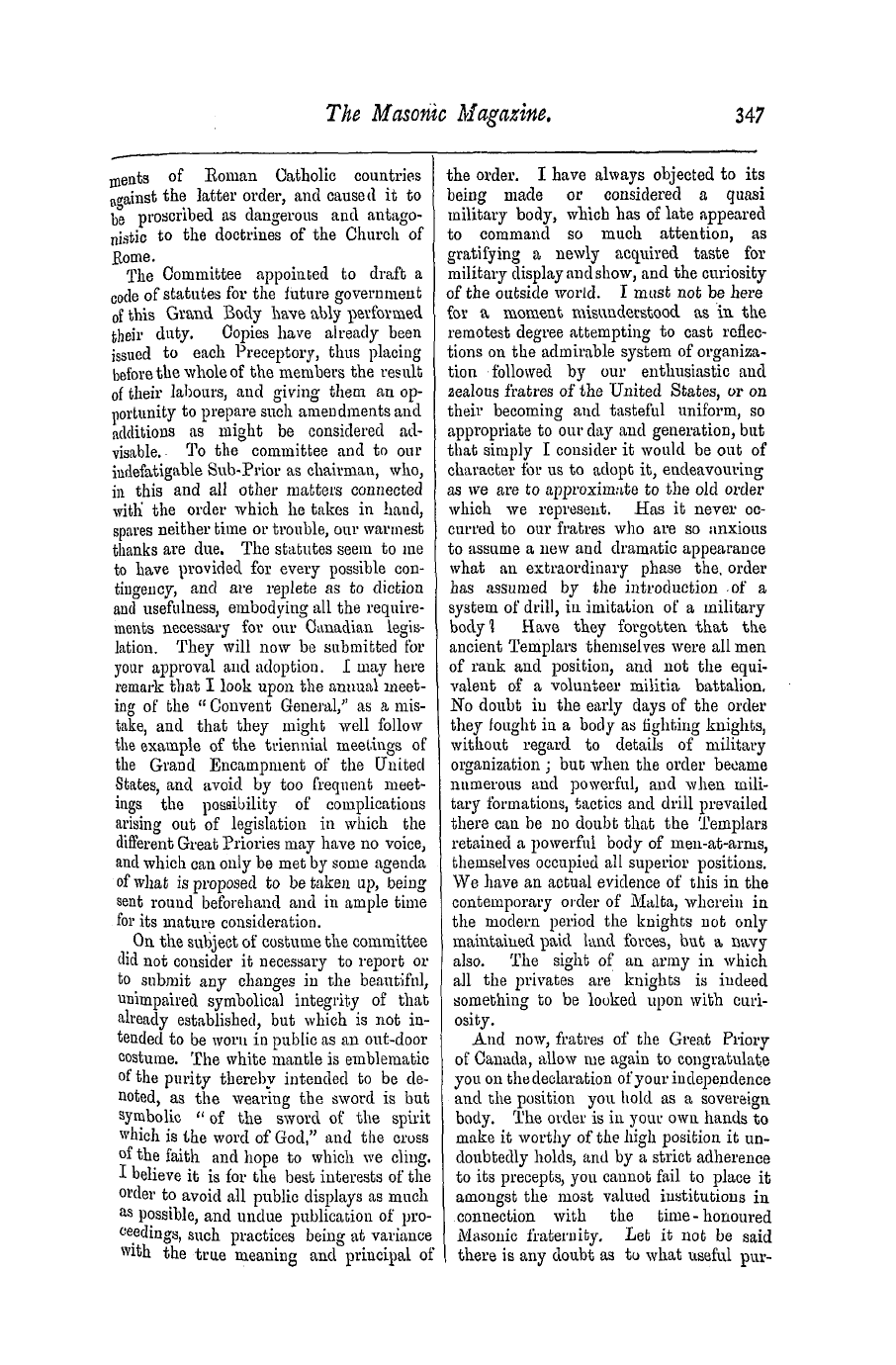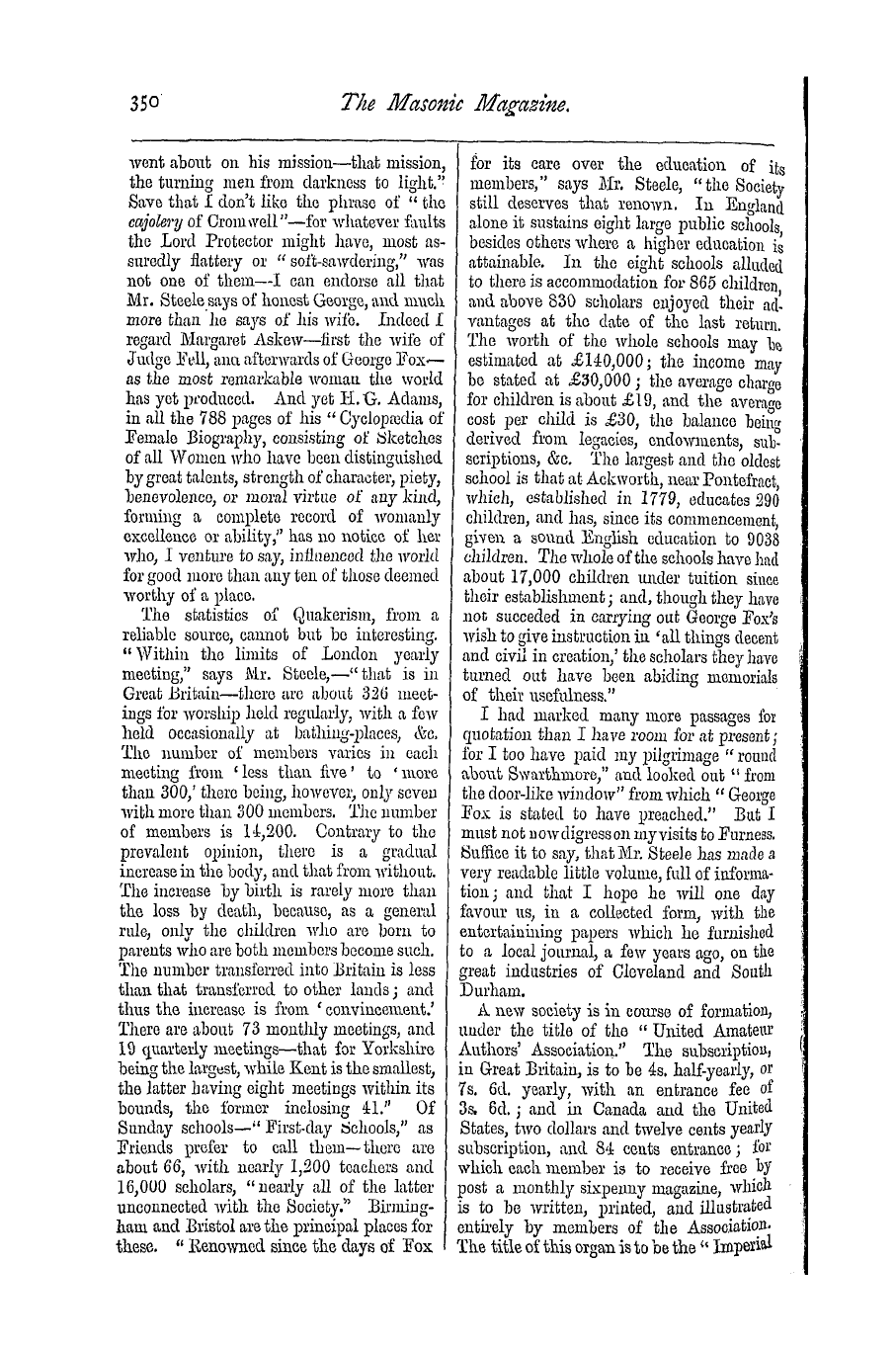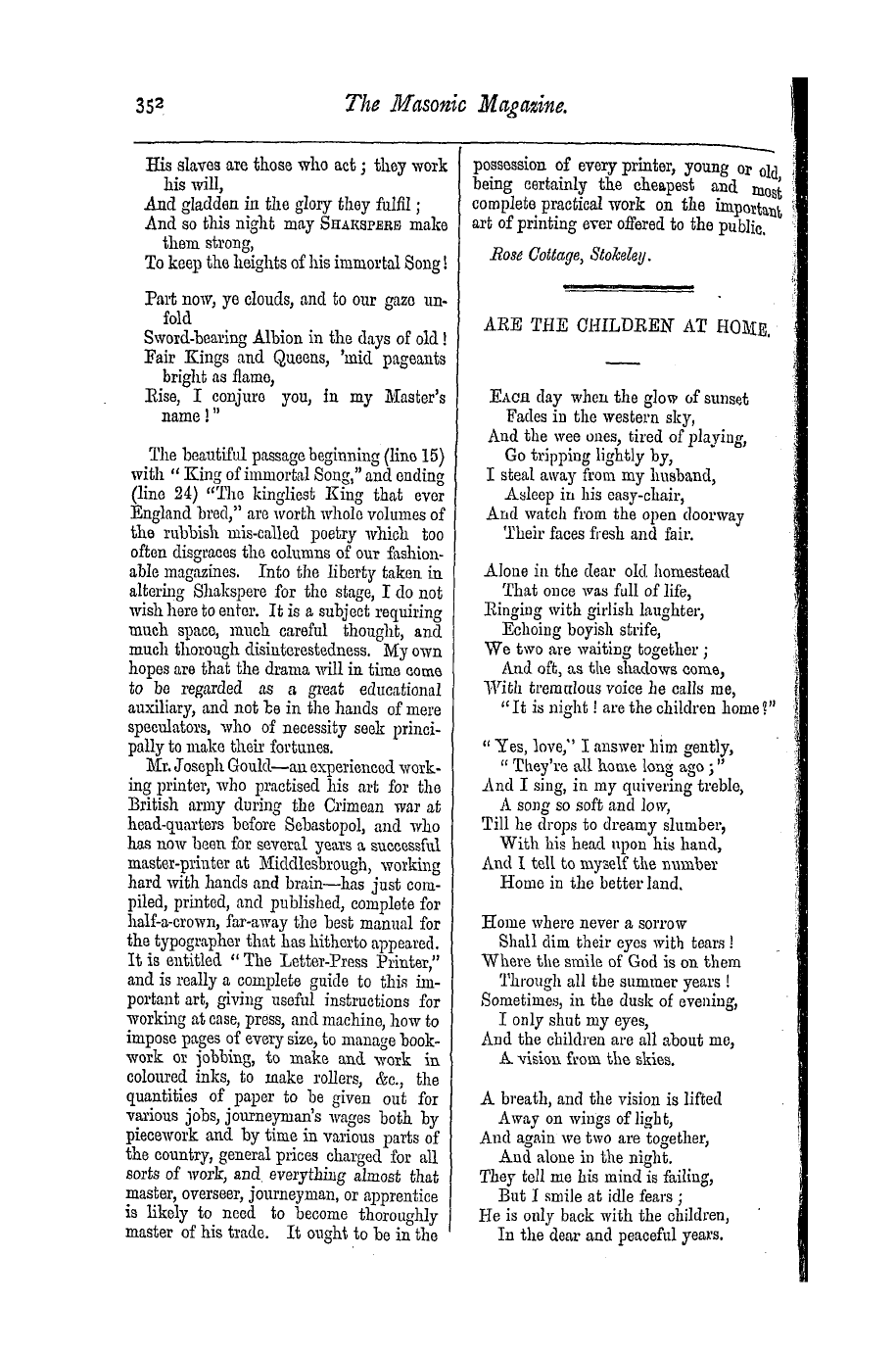-
Articles/Ads
Article FATHER FOY ON SECRET SOCIETIES. ← Page 2 of 8 →
Note: This text has been automatically extracted via Optical Character Recognition (OCR) software.
Father Foy On Secret Societies.
• when such societies began to show themselves . If they conversed with those who belonged to various secret societies they would tell them about these bodies that they were conspicuous at the time Solomon built his temple , and that one of their
members—a mason—was remarkable for his skill , and that he was killed from envv . Then they claimed a descent throug h various periods until they came to the time of the Gnostics and ManicliMns , in the first five centuriesand ultimatel
, y throug h the Knights Templars . When that order was broken up by a Pope and General Council , it was alleged that certain Knights Templars establised themselves at Aberdeen , in Scotland , and secretly retained in certain caves , those , the odious
practises for which they had been condemned . Tn course of time , it was asserted they grew in numbers , and were called Scottish Knights or Masons . When the Stuarts left England for France , they began to have rapid propagation throughout the world . This was the account
given about these societies in the first period . He would not dwell much on this , as when these societies were rapidly spreading themselves there came to be certain great doubts as to what was reall y done in those caves near Aberdeen , where
these Kni ghts Templars first hid themselves . Members were sent from France to investigate the question , and the end of it was that no one in Aberdeen could throw any light upon these questions . That he quoted from Ro bison , a Scotch writer of great ability . In some way or other it was possible that there was some connection between some of these secret
societies of the present time and those of Aberdeen . There was the Grand Master , aud the custom of guarding the Temple , as a meeting or lodge was termed , and persons were also put on the roof to guard the place , in accordance with the practices the
° t former Kni ghts Templars . In ttany such ways there was a similiarity between the Freemasons and the Knights ^ mplars . The first of the three bran ches 01 secret societies of the earlier period was called the Hermetic Scottish Ritethe
or ; second was that of the Cabalistic , or of , ^ aw-chsean type , which rested on the ^ me , . theory as that of the Manichceans ; ™< l the third was that of the Eclectics or
Philosophers , who merged , at the time of the French Revolution , all these former secret societies into their own peculiar shape , resulting in the wickedness of the French Revolution . The distinguishing badge of the first , or Scottish Rite , was distinctly that of Pantheism . It said there was a God who governed the world , but who was no more than the soul of this
world , and that the whole of this world was a part of this God , and that if you destroyed a grain of sand you destroyed a part of the Deity . Thus they destroyed the personality of God . Good men and bad men were all of them part of this
creative principle , or God , thus making God bad as well as good . By this principle a person thus raised himself to be God , and they said frequently " We are gods , as we are part of God , and owe no responsibility to anyone , as we are gods
ourselves , and there is no one higher than ourselves to whom we are responsible . " This was the main principle of the first division of the early secret societies . The second was the Cabalistic Societies , as they were termedand their principles were
, equally bad , as being those of the Maniehsens , who taught that there was a good God and an evil one ; further , that the flesh of man was made by the evil God , and therefore that it could not be called to
account for any wickedness on its partprinciples which aimed at the destruction of mankind . In 1748 , the so called Eclectics worked together the kindred secret societies into a far worse shape , which , for infamous principles , then
exceeded anything that had been in existence before that . Coming to this second period of secret societies founded , as we mi ght say by the Eclectic sect of philosophersfor they called themselves by that namethat movement began in 1748 and had
, for its founder Dr . Adam Weishaul pt , of Ingolstadt , in Bavaria , who was described as the most infamous of mankind . This was the starting of Illuminism , which spread throughout Germany in six months to an incredible extent , and in a short time
its tenets found their way all over Europe , and had more to do with the evils of the French Revolution than any other cause whatever . This principle was called that of Illuniinati , or that of Illuminism , or Illumination , and the persons believing
Note: This text has been automatically extracted via Optical Character Recognition (OCR) software.
Father Foy On Secret Societies.
• when such societies began to show themselves . If they conversed with those who belonged to various secret societies they would tell them about these bodies that they were conspicuous at the time Solomon built his temple , and that one of their
members—a mason—was remarkable for his skill , and that he was killed from envv . Then they claimed a descent throug h various periods until they came to the time of the Gnostics and ManicliMns , in the first five centuriesand ultimatel
, y throug h the Knights Templars . When that order was broken up by a Pope and General Council , it was alleged that certain Knights Templars establised themselves at Aberdeen , in Scotland , and secretly retained in certain caves , those , the odious
practises for which they had been condemned . Tn course of time , it was asserted they grew in numbers , and were called Scottish Knights or Masons . When the Stuarts left England for France , they began to have rapid propagation throughout the world . This was the account
given about these societies in the first period . He would not dwell much on this , as when these societies were rapidly spreading themselves there came to be certain great doubts as to what was reall y done in those caves near Aberdeen , where
these Kni ghts Templars first hid themselves . Members were sent from France to investigate the question , and the end of it was that no one in Aberdeen could throw any light upon these questions . That he quoted from Ro bison , a Scotch writer of great ability . In some way or other it was possible that there was some connection between some of these secret
societies of the present time and those of Aberdeen . There was the Grand Master , aud the custom of guarding the Temple , as a meeting or lodge was termed , and persons were also put on the roof to guard the place , in accordance with the practices the
° t former Kni ghts Templars . In ttany such ways there was a similiarity between the Freemasons and the Knights ^ mplars . The first of the three bran ches 01 secret societies of the earlier period was called the Hermetic Scottish Ritethe
or ; second was that of the Cabalistic , or of , ^ aw-chsean type , which rested on the ^ me , . theory as that of the Manichceans ; ™< l the third was that of the Eclectics or
Philosophers , who merged , at the time of the French Revolution , all these former secret societies into their own peculiar shape , resulting in the wickedness of the French Revolution . The distinguishing badge of the first , or Scottish Rite , was distinctly that of Pantheism . It said there was a God who governed the world , but who was no more than the soul of this
world , and that the whole of this world was a part of this God , and that if you destroyed a grain of sand you destroyed a part of the Deity . Thus they destroyed the personality of God . Good men and bad men were all of them part of this
creative principle , or God , thus making God bad as well as good . By this principle a person thus raised himself to be God , and they said frequently " We are gods , as we are part of God , and owe no responsibility to anyone , as we are gods
ourselves , and there is no one higher than ourselves to whom we are responsible . " This was the main principle of the first division of the early secret societies . The second was the Cabalistic Societies , as they were termedand their principles were
, equally bad , as being those of the Maniehsens , who taught that there was a good God and an evil one ; further , that the flesh of man was made by the evil God , and therefore that it could not be called to
account for any wickedness on its partprinciples which aimed at the destruction of mankind . In 1748 , the so called Eclectics worked together the kindred secret societies into a far worse shape , which , for infamous principles , then
exceeded anything that had been in existence before that . Coming to this second period of secret societies founded , as we mi ght say by the Eclectic sect of philosophersfor they called themselves by that namethat movement began in 1748 and had
, for its founder Dr . Adam Weishaul pt , of Ingolstadt , in Bavaria , who was described as the most infamous of mankind . This was the starting of Illuminism , which spread throughout Germany in six months to an incredible extent , and in a short time
its tenets found their way all over Europe , and had more to do with the evils of the French Revolution than any other cause whatever . This principle was called that of Illuniinati , or that of Illuminism , or Illumination , and the persons believing



































































